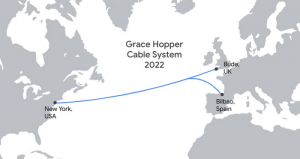There’s no such thing as too much subsea bandwidth, or at least there isn’t when you’re Google. The tech giant announced yesterday yet another new subsea cable project, this time under the Atlantic.
The ‘Grace Hopper’ cable will connect New York with both the UK and Spain. On the European side the landings would be in Bude and Bilbao, but in the US the announcement was not yet clear if we’re talking about Long Island or New Jersey. It will consist of no less than 16 fiber pairs and will be constructed with the help of SubCom.
 The cable will be named for Grace Brewster Murray Hopper, a major early figure in the world of computer science. She played a role in the first compilers and in the development of COBOL.
The cable will be named for Grace Brewster Murray Hopper, a major early figure in the world of computer science. She played a role in the first compilers and in the development of COBOL.
The target date for the Grace Hopper cable is 2022. That would be a rather accelerated schedule for anyone who needed to raise the money, but of course this is Google so let’s get that survey underway.
If you haven't already, please take our Reader Survey! Just 3 questions to help us better understand who is reading Telecom Ramblings so we can serve you better!
Categories: Undersea cables





Sixteen pair seems like a lot for a transoceanic run. I wonder if this is strictly in-house or if they’ll make it available to other entities.
There has been a bunch of interesting work over the last few years that showed that it was more efficient to use more pairs with less spectrum than trying to drive more esoteric modulation schemes etc…
https://www.infinera.com/blog/suboptic-2019-hot-topics-the-three-roads-to-subsea-fiber-capacity is a random vendor post on the topic but the math is common
Apart from providing the widest possible range of services for the disabled, BMVSS is also focused on research and development, and tries to combine service with science. For more visit: http://jaipurfoot.org